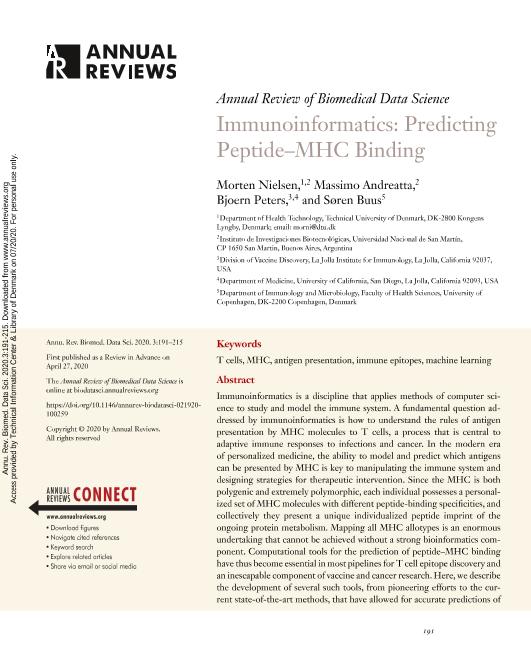Mostrar el registro sencillo del ítem
dc.contributor.author
Nielsen, Morten

dc.contributor.author
Andreatta, Massimo

dc.contributor.author
Peters, Bjoern

dc.contributor.author
Buus, Søren

dc.date.available
2021-09-17T12:35:59Z
dc.date.issued
2020-07
dc.identifier.citation
Nielsen, Morten; Andreatta, Massimo; Peters, Bjoern; Buus, Søren; Immunoinformatics: Predicting Peptide–MHC Binding; Annual Review; Annual Review of Biomedical Data Science; 3; 1; 7-2020; 191-215
dc.identifier.issn
2574-3414
dc.identifier.uri
http://hdl.handle.net/11336/140643
dc.description.abstract
Immunoinformatics is a discipline that applies methods of computer science to study and model the immune system. A fundamental question addressed by immunoinformatics is how to understand the rules of antigen presentation by MHC molecules to T cells, a process that is central to adaptive immune responses to infections and cancer. In the modern era of personalized medicine, the ability to model and predict which antigens can be presented by MHC is key to manipulating the immune system and designing strategies for therapeutic intervention. Since the MHC is both polygenic and extremely polymorphic, each individual possesses a personalized set of MHC molecules with different peptide-binding specificities, and collectively they present a unique individualized peptide imprint of the ongoing protein metabolism. Mapping all MHC allotypes is an enormous undertaking that cannot be achieved without a strong bioinformatics component. Computational tools for the prediction of peptide?MHC binding have thus become essential in most pipelines for T cell epitope discovery and an inescapable component of vaccine and cancer research. Here, we describe the development of several such tools, from pioneering efforts to the current state-of-the-art methods, that have allowed for accurate predictions of peptide binding of all MHC molecules, even including those that have not yet been characterized experimentally.
dc.format
application/pdf
dc.language.iso
eng
dc.publisher
Annual Review
dc.rights
info:eu-repo/semantics/openAccess
dc.rights.uri
https://creativecommons.org/licenses/by-nc-sa/2.5/ar/
dc.subject
T cells
dc.subject
MHC
dc.subject
Antigen presentation
dc.subject.classification
Otras Ciencias de la Salud

dc.subject.classification
Ciencias de la Salud

dc.subject.classification
CIENCIAS MÉDICAS Y DE LA SALUD

dc.title
Immunoinformatics: Predicting Peptide–MHC Binding
dc.type
info:eu-repo/semantics/article
dc.type
info:ar-repo/semantics/artículo
dc.type
info:eu-repo/semantics/publishedVersion
dc.date.updated
2021-08-25T19:40:01Z
dc.journal.volume
3
dc.journal.number
1
dc.journal.pagination
191-215
dc.journal.pais
Estados Unidos

dc.description.fil
Fil: Nielsen, Morten. Consejo Nacional de Investigaciones Científicas y Técnicas. Centro Científico Tecnológico Conicet - La Plata. Instituto de Investigaciones Biotecnológicas. Universidad Nacional de San Martín. Instituto de Investigaciones Biotecnológicas; Argentina. Technical University of Denmark; Dinamarca
dc.description.fil
Fil: Andreatta, Massimo. Consejo Nacional de Investigaciones Científicas y Técnicas. Centro Científico Tecnológico Conicet - La Plata. Instituto de Investigaciones Biotecnológicas. Universidad Nacional de San Martín. Instituto de Investigaciones Biotecnológicas; Argentina
dc.description.fil
Fil: Peters, Bjoern. La Jolla Institute for Allergy and Immunology; Estados Unidos
dc.description.fil
Fil: Buus, Søren. Universidad de Copenhagen; Dinamarca
dc.journal.title
Annual Review of Biomedical Data Science
dc.relation.alternativeid
info:eu-repo/semantics/altIdentifier/url/https://www.annualreviews.org/doi/10.1146/annurev-biodatasci-021920-100259
dc.relation.alternativeid
info:eu-repo/semantics/altIdentifier/doi/http://dx.doi.org/10.1146/annurev-biodatasci-021920-100259
Archivos asociados
